|
Glittering Angel
www.flickr.com
This is a Flickr badge showing public photos and videos from Glittering Angel. Make your own badge here.
R.O.M. on 7 Sep '08 Recent Rants Kunming & Bangkok (5-12 Nov 2005): Day 3 Kunming & Bangkok (5-12 Nov 2005): Day 2 Kunming & Bangkok (5-12 Nov 2005): Day 1 Before & After Stomach Flu Attack Back from Holiday & Down with Stomach Flu Rushed... Packed... Finally READY! Friends
Alvin Travel Entries
Kunming & Bangkok Ho Chi Minh City (22 - 26 December 2006) 
Bangkok (4 - 8 August 2007) 
Chiangmai (6 - 10 December 2007) 
Cambodia (15 - 20 July 2008) 
Korea with Jeju (4 - 10 April 2008) 
Archives
Credits Given |
Sunday, November 27, 2005 Tuesday, 8 November 2005 It was a wet and rainy morning and we were heading for Dragon Gate at the Western Hill. Known as 西山龙门 in Chinese, Dragon Gate is the steepest spot in Western Hills and well worth climbing up the winding oldWhile going to Dragon Gate, we had to pass 滇池 (Dianchi Lake) located at the foot of 西山 (Western Hills). It is south-west of Kunming and being the largest lake in Kunming and 6th largest fresh water in China, it is also known as "Pearl of the Plateau" (云南高原上的一颗明珠). The ride to Western Hills was quite bumpy as it was raining and the terrain was quite rocky. On our way up the hills, we actually saw many natives walking up, and in the rain. Jiaxing was telling us that the natives staying at the bottom of Western Hills will go up the hills daily to fetch water as they believe that the water above is much fresher and has healing power. When we reached Western Hills, we have to take a Tram up to Dragon Gate. This is because the Tram runs on electricity and will not harm the natural Dragon Gate environment, like motor vehicles do.
It was still raining when we reached 西山龙门 (Dragon Gate) so we got to buy an umbrella. The stairway was realyl slippery due to the rain and so narrow that one could trip quite easily. The view was not so spectacular as it was pretty misty from the rain. After climbing a while up the winding stairway, we finally reached the top.
After 西山龙门 (Dragon Gate), we headed for lunch at a local place highly recommended by Jiaxing. It was at 过桥园 (Guo Qiao Yuan) where they served their popularly known 过桥面线 (i.e. some noodles with oil-ladened soup).
Apparently the soup was really hot beneath as the layer of oil above prevent heat loss and ensure the soup remained hot. Well, the story goes like this. Sometime, somewhere in ancient China, there was a scholar who was preparing for his provincial exam and in order to get peace from his studies, he decided to go up the mountains for his study session. The wife would stay home though. However, his wife would have to bring food for him everyday up the mountains and by the time food reached the scholar, will turn cold. Hence, she came up with this dish of 过桥面线 so that by the time her husband wanted to have the noodles, it would still be hot as the soup warmth is protected by the layer of oil.
Well, I hate to say this but it's really horrible. Too freaking oily. Mummy and me only ate like 2 mouthfuls of the noodles, with its ingredients inside.
Not exactly a very filling lunch but well, at least we tried their local specialty. After lunch, we headed to the Yunnan Agricultural University which specialises/studies their local Yunnan 普洱茶 (Pu Er Tea). In a nutshell, 普洱茶 (Pu Er Tea) is supposed to reduce one's chloestrol level and also high blood pressure. It has also been proven in some japanese research on weight loss. And I was truly surprised to learn that 普洱茶 (Pu Er Tea) actually comes in a big biscuit for. Mummy and myself were taught by the graduates there that 普洱茶 (Pu Er Tea) can never be concealed in a bottle or tea bag. Well, from what I remember, tea leaves I bought were all in tea bags or in bottles of tea leaves. Anyway 普洱茶 (Pu Er Tea) is a Dark Tea and quite different from the Green Tea we normally take. Green tea can only be kept for not more than 3 years or the effects will wear off. However, for 普洱茶 (Pu Er Tea), the longer it is, the more benefits it has and taste nicer. Sweeter too. Not sugar sweet kind but more from the brew of the tea.
After tasting, we concluded: 5 Year Old 普洱茶 (Pu Er Tea) tastes really bitter. 12 Year Old 普洱茶 (Pu Er Tea) tastes milder and soothing. 180 YUAN (SG$38) per box. 20 Year Old 普洱茶 (Pu Er Tea) tastes very soothing and sweet. 250 YUAN (SG$54) per box. One biscuit of 普洱茶 (Pu Er Tea) can averagely last 1 month for 1 person's consumption. Anyway, we bought a lot of boxes. Not just 普洱茶 (Pu Er Tea) but also another tea herbs. Need not elaborate much though.
After 普洱茶 (Pu Er Tea) shopping, we happily headed for 圆通寺 (Yuan Tong Temple), the grandest Buddhist temple in Yunnan Province. King Yimouxun of the Nanzhao Kingdom built the temple during the late eighth century as a continuation of Putuoluo Temple, and the restorations to the temple performed from the Qing Dynasty onward had not changed 圆通寺 (Yuan Tong Temple)'s unique mixed architectural style of the Yuan and Ming Dynasties.
Dinner was good. Jiaxing and our driver, 张师父 (Mr Zhang) treated us to have some local dishes at a restaurant. Food was nice. 谢谢家鑫和张师父! |

















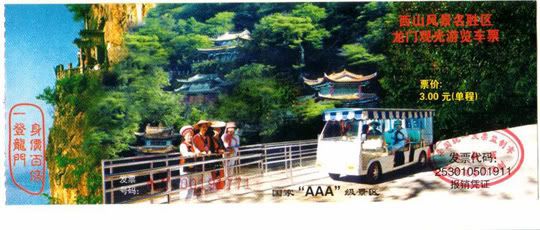
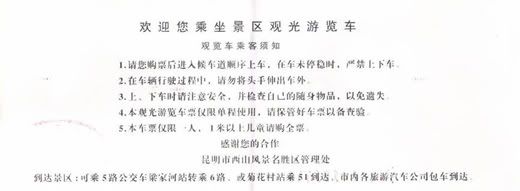
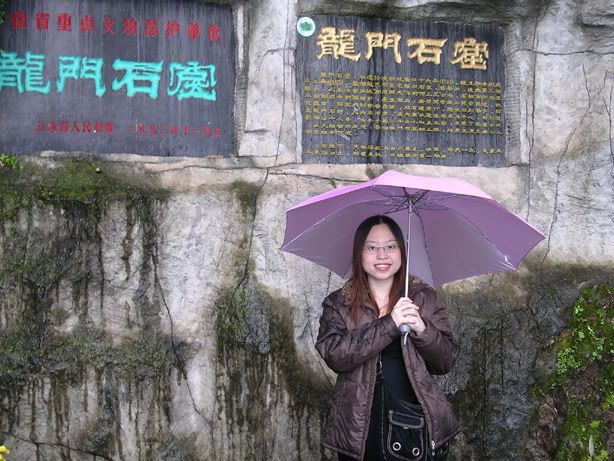
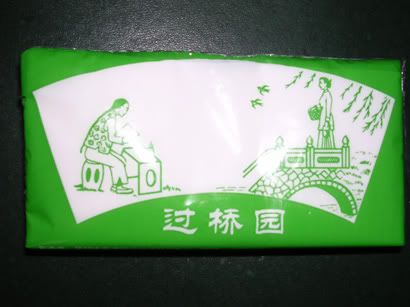

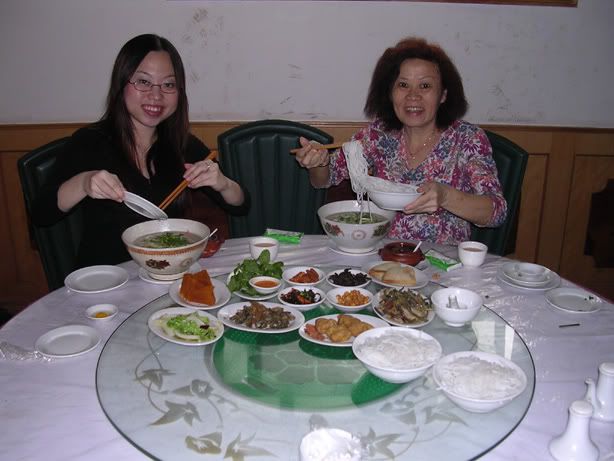


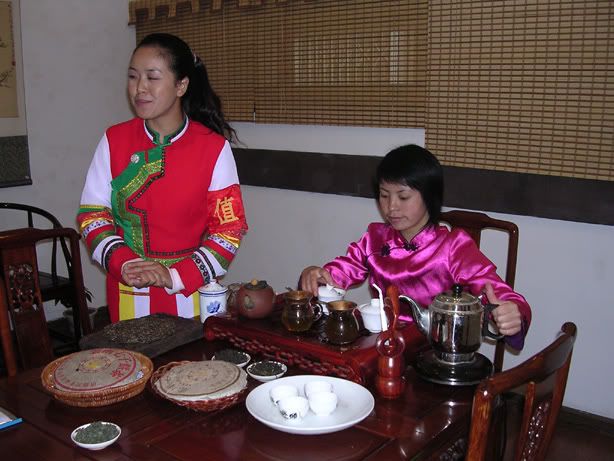

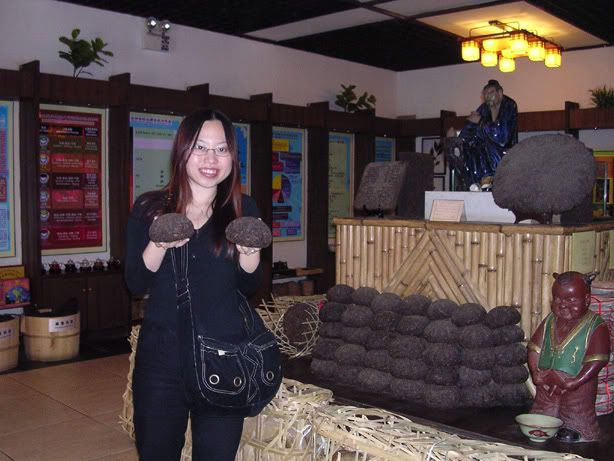

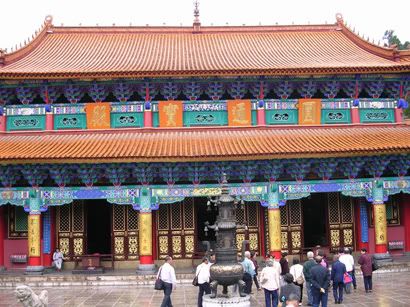
 by Glittering Angel @ 6:58 pm ||
by Glittering Angel @ 6:58 pm ||